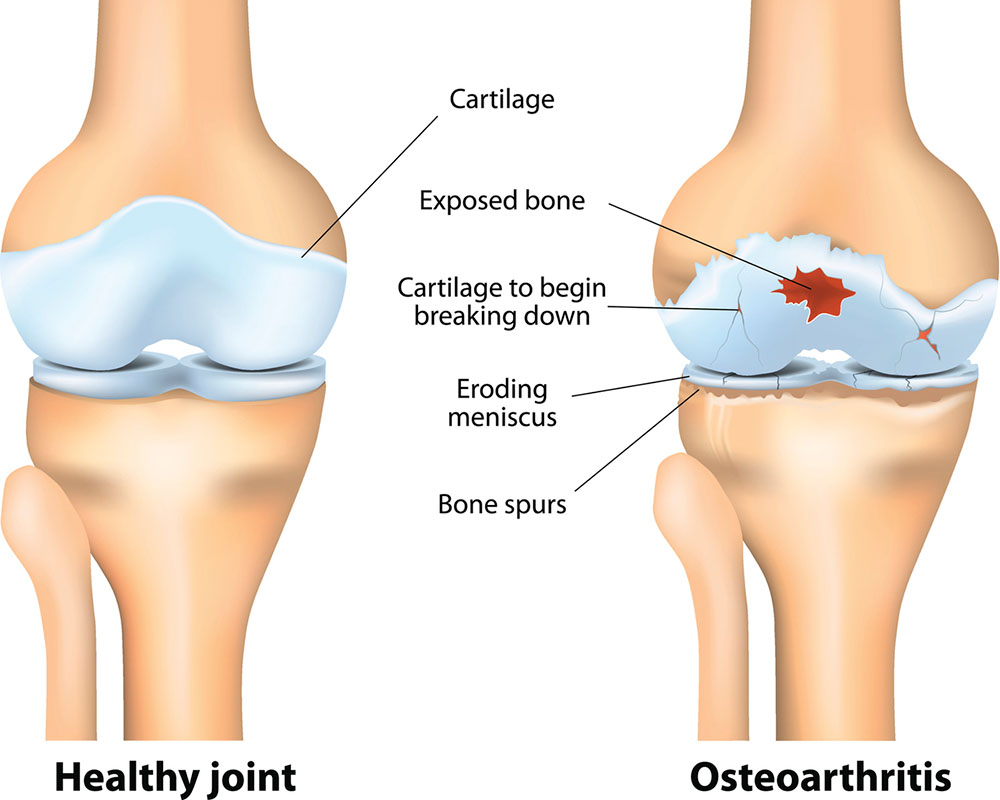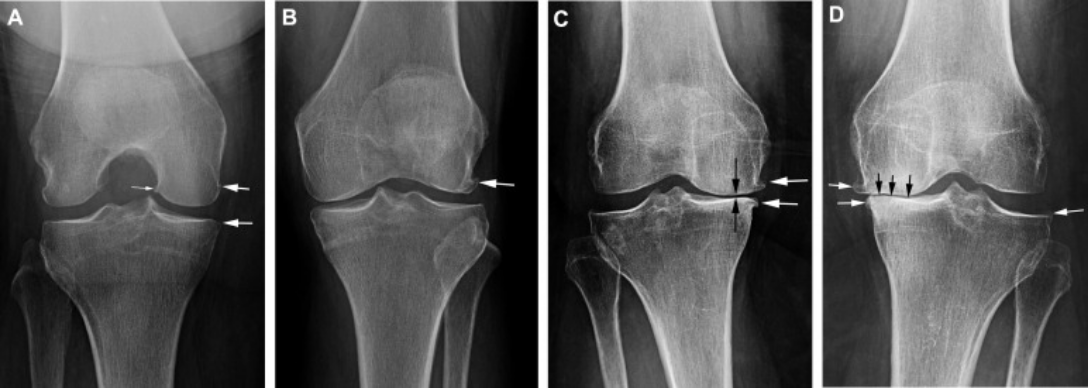Phases of Osteoarthritis and Knee Degeneration

Musculoskeletal joint conditions are extremely prevalent in the US. Osteoarthritis (OA) is the most common of the dozens of forms of arthritis.
The Center for Disease Control and Prevention predicted that by 2020, arthritis will gain more patients than any other disease form in America 1, 2.
Osteoarthritis can affect any joint but most often occurs in the fingers, wrists, knees, hips, lower back, and neck.
Typical symptoms include joint pain, swelling, redness, stiffness, instability, immobility, or crepitus (crackling, popping, or squeaking sounds emanating from the joint). Because OA is a degenerative disease related to “wear and tear” of the cartilage in the affected joint, symptoms gradually worsen over time.
Age is the biggest risk factor for OA (but trauma to joints due to accidents or sports injuries are also significant risk factors). Gender is also a major risk factor in that OA is more common in women than men.
In the United States, symptomatic knee Osteoarthritis alone affects almost 10% of males and 13% females over the age of 60. Indeed, knee pain is one of the most common joints for which people seek out treatment from an orthopedic doctor or surgeon.
The purpose of this article is to provide an overview of the pathophysiology of osteoarthritic knee degeneration.
The mechanical forces the cartilage, ligaments, and tendons in the knee must absorb to protect the bones comprising the joint are significant.
Fibrous pads of cartilage called menisci (singular, meniscus) and a thin layer of articular cartilage that covers the end of the femur are vital to reduce friction between abutting bones the knee. Considered the most durable type of cartilage, the menisci are largely composed of strong collagen fibers that increase stability for femorotibial articulation, distribute axial load, absorb shock, and provide lubrication and nutrition to the knee joint.
The main function of articular cartilage is to provide a smooth, lubricated surface for low friction movements that helps distribute mechanical forces over the surface of the underlying bone.
Osteoarthritis (OA) develops and worsens slowly over time and is thus classified as a degenerative disease. Overtime, the outer layers of the menisci wear down leading to a loss of joint space which increases friction on the thinner weaker articular cartilage which can then become damaged further increasing the friction between abutting bones causing pain, swelling, stiffness, and decreased mobility.
Loss of joint space due to damaged or missing menisci or articular cartilage and can also be accompanied by the growth of osteophytes or bones spurs, making it painful to extend and bend the leg.

Figure 1 Phases of Osteoarthritic Knee Degeneration. A) Black arrows point to the joint space between the femur and tibia in a healthy knee. B) Osteophyte formation is denoted by the white arrow marking the beginning of clinically graded osteoarthritis. C) Joint space gradually lessens with disease progression ultimately leading to D) a near complete loss of joint space in severe osteoarthritis, denoted by black arrows.
The Kellgren and Lawrence (KL) system is a common method used by orthopedic doctors and surgeons to classify the severity of OA. The KL system can be used to chart a patient’s disease progression and is used as an outcome measure in clinical research studies evaluating the efficacy of various treatment modalities. While the KL system can be used to describe OA in many different joints, we illustrate its use to describe OA in the knee using X-ray images as seen in Figure 1.
Five grades (0-4) are used to rate disease severity. In general, subjective pain is non-existent or minimal in grades 0-2 and increases significantly during grade 3, altering the quality of life. By stage 4 disease, pain and lack of mobility can be debilitating.
The following is a summary of KL grading system for OA3:
- grade 0 (none): definite absence of X-ray changes of osteoarthritis
- grade 1 (doubtful): doubtful joint space narrowing and possible osteophytic lipping
- grade 2* (minimal): definite osteophytes and possible joint space narrowing
- grade 3 (moderate): moderate multiple osteophytes, definite narrowing of joint space and some sclerosis and possible deformity of bone ends
- grade 4 (severe): large osteophytes, marked narrowing of joint space, severe sclerosis and definite deformity of bone ends
*Osteoarthritis is deemed present at grade 2 although of minimal severity
In Figure 1, four X-rays of the knee are shown depicting progressive osteoarthritic degeneration.
Fig. 1A shows a normal knee of a younger person corresponding to grades 0 and/or 1 on the KL scale. At this point OA cannot yet be diagnosed. Note the ample amount of space between the abutting femur (top) and tibia (bottom) bones.
Fig. 1B Corresponds to grade 2 on the KL scale, where osteophytes or bone spurs are forming but loss of joint space remains questionable.
Fig. 1C shows a loss of joint space between the femur and tibia corresponding to moderate or grade 3 OA. Significant pain is typically reported by patients by this point. Physical therapy together with conventional drug therapies and regenerative medicine therapies are typically recommended or should be considered at this point. Conventional drug therapies include painkillers, NSAIDs, and corticosteroids.
Advanced Regenerative medicine treatments include growth factors, platelet-rich plasma injections, and prolotherapy. Fig. 1D shows the near complete loss of joint space commonly referred to as “bone on bone” corresponding to grade 4 OA. Pain experienced by patients may continue to increase from grade 3 to grade 4 OA and mobility may be severely limited at this point.
Orthopedic surgeons often recommend joint replacement surgeries although regenerative medicine therapies may offer effective alternatives to postpone or avoid surgical procedures depending on the state of their disease or if surgery is not an option. Because regenerative medicine procedures fall outside the expertise of surgeons, they may not always offer these options readily to patients. It is therefore essential patients are educated about all available treatment options in order to determine their best treatment options.
To summarize, Osteoarthritis (OA) is a very common form of arthritis with many risk factors for developing the disease, where age, activity levels, and sex are among the most significant. The disease involves the cartilage degeneration leading to increased friction within joints that can cause significant pain an immobility.
The KL scale is used to score or grade OA disease progression. When considering treatment options, patients with OA should consult with their doctors to evaluate the risks and side effects of conventional drug therapies and surgical interventions.
Regenerative medicine approaches offer non-pharmaceutical options to promoting healing, relieve pain, and restore mobility.
References
- Centers for Disease Control and Prevention (CDC) Arthritis prevalence and activity limitations: United States, 1990. MMWR Morb Mortal Wkly Rep. 1994;43(24):433–438. [PubMed] [Google Scholar]
- From the Centers for Disease Control and Prevention. Arthritis prevalence and activity limitation–United States, 1990. 1994;272(5):346–347. [PubMed] [Google Scholar]
- Kellgren, JK; Lawrence, JS. Radiological assessment of osteo-arthrosis. Ann Rheum Dis. Dec;16(4):494-502.
Recent Posts

BMI and Weight Loss: Understanding the Impact on Health
Body Mass Index (BMI) serves as a widely used tool for assessing weight status relative to height, offering valuable insights

Faqs About Regenerative Medicine and Stem Cell Treatment
Common-faqs-regenerative-medicines-and-stemcell-treatment

Five Habits that Could Be Worsening Your Knee Pain
Five Habits that Could Be Worsening Your Knee Pain

Regenerative Medicine Treatments for Tennis and Golfer’s Elbow
Overuse and repetitive contractions of the muscles and tendons of the forearm ...



